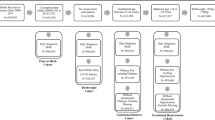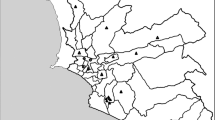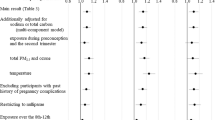Abstract
Fetus death risk reduction is included in the United Nations Sustainable Development Goals. However, little is known about how missed abortion in the first trimester (MAFT) is related to maternal air pollution exposure. We quantify the link between air pollution exposure and MAFT in Beijing, China, a region with severe MAFT and air quality problems. We analyse the records of 255,668 pregnant women from 2009 to 2017 and contrast them with maternal exposure to air pollutants (particulate matter PM2.5, SO2, O3 and CO). We adjust for confounding factors such as sociodemographic characteristics, spatial autocorrelation and ambient temperature. We find that, for all four pollutants, an increased risk of MAFT is associated with rises in pollutant concentrations and the adjusted odds ratios (ORs) of these associations increase with higher concentrations. For example, the adjusted OR of MAFT risk for a 10.0 μg m−3 increase in SO2 exposure is between 1.29 and 1.41 at concentrations of 7.1–19.5 μg m−3; it drops to 1.17 below this range and rises to 1.52 above it at higher SO2 concentrations. This means that the risk increase is not linear but becomes more severe the higher the pollutant concentration. The findings provide evidence linking fetus disease burden and maternal air pollution exposure.
This is a preview of subscription content, access via your institution
Access options
Access Nature and 54 other Nature Portfolio journals
Get Nature+, our best-value online-access subscription
$29.99 / 30 days
cancel any time
Subscribe to this journal
Receive 12 digital issues and online access to articles
$119.00 per year
only $9.92 per issue
Buy this article
- Purchase on Springer Link
- Instant access to full article PDF
Prices may be subject to local taxes which are calculated during checkout


Similar content being viewed by others
Data availability
The collected data are available from the corresponding authors on reasonable request.
Code availability
The source code is available from the corresponding authors on reasonable request. It is copyrighted by Beijing Normal University and Beijing Obstetrics and Gynecology Hospital and is to be used only for educational and research purposes. Any commercial use is prohibited.
References
Cohen, A. J. et al. Estimates and 25-year trends of the global burden of disease attributable to ambient air pollution: an analysis of data from the Global Burden of Diseases Study. Lancet 389, 1907–1918 (2015).
Jing, H. et al. Health impact of China’s air pollution prevention and control action plan: an analysis of national air quality monitoring and mortality data. Lancet Planet. Health 2, e313–e323 (2018).
Shah, P. S. et al. Air pollution and birth outcomes: a systematic review. Environ. Int. 37, 498–516 (2011).
Malley, C. S. et al. Preterm birth associated with maternal fine particulate matter exposure: a global, regional and national assessment. Environ. Int. 101, 173–182 (2017).
Brook, R. D. et al. Insights into the mechanisms and mediators of the effects of air pollution exposure on blood pressure and vascular function in healthy humans. Hypertension 54, 659–667 (2009).
Dadvand, P. et al. Ambient air pollution and preeclampsia: a spatiotemporal analysis. Environ. Health Perspect. 121, 1365–1371 (2013).
Ha, S. et al. Ambient air pollution and the risk of pregnancy loss: a prospective cohort study. Fertil. Steril. 109, 148–153 (2017).
Gemzell-Danielsson, K. et al. Misoprostol to treat missed abortion in the first trimester. Int. J. Gynaecol. Obstet. 99, S182–S185 (2007).
Steer, C. et al. Spontaneous abortion rates after natural and assisted conception. BMJ 299, 1317–1318 (1989).
Daya, S. in Textbook of Gynecology (ed. Copeland, L. J.) 227–271 (WB Saunder, 2000).
Wood, S. Medical management of missed abortion: a randomized clinical trial. Obstet. Gynecol. 99, 563–566 (2002).
Farah, S. & Lucy, K. Intrauterine fetal death. Obstet. Gynaecol. Reprod. Med. 19, 1–6 (2009).
Green, R. S. et al. Residential exposure to traffic and spontaneous abortion. Environ. Health Perspect. 117, 1939–1944 (2009).
Defranco, E. et al. Air pollution and stillbirth risk: exposure to airborne particulate matter during pregnancy is associated with fetal death. PLoS ONE 10, e0120594 (2015).
Hou, H. Y. et al. Does ambient air pollutants increase the risk of fetal loss? A case-control study. Arch. Gynecol. Obstet. 289, 285–291 (2014).
Liang, X. et al. PM2.5 data reliability, consistency, and air quality assessment in five Chinese cities. J. Geophys. Res. Atmos. 121, 10220–10236 (2016).
Ji, J. Air pollution and China’s ageing society. Lancet Public Health 3, e457–e458 (2018).
Bowe, B. et al. The 2016 global and national burden of diabetes mellitus attributable to PM2.5, air pollution. Lancet Planet. Health 2, e301–e312 (2018).
Chen, H. Living near major roads and the incidence of dementia, Parkinson’s disease, and multiple sclerosis: a population-based cohort study. Lancet 389, 718–726 (2017).
Smith, R. et al. Impact of London’s road traffic air and noise pollution on birth weight: retrospective population based cohort study. BMJ 359, j5299 (2017).
Wang, Y. et al. Association of long-term exposure to airborne particulate matter of 1 μm or less with preterm birth in China. JAMA Pediatr. 8, e174872 (2018).
Mahalingaiah, S. et al. Perimenarchal air pollution exposure and menstrual disorders. Hum. Reprod. 33, 512–519 (2018).
Wakefield, J. Bayes factors for genome-wide association studies: comparison with P-values. Genet. Epidemiol. 33, 79–86 (2009).
Lee, M. D. & Wagenmakers, E.-J. Bayesian Cognitive Modeling: A Practical Course (Cambridge Univ. Press, 2013).
Schönbrodt, F. D. & Wagenmakers, E. J. Bayes factor design analysis: planning for compelling evidence. Psychon. Bull. Rev. 25, 128–142 (2018).
Patt, A. G. et al. Estimating least-developed countries’ vulnerability to climate-related extreme events over the next 50 years. Proc. Natl Acad. Sci. USA 107, 1333–1337 (2010).
Smith, K. R. et al. in Climate Change 2014: Impacts, Adaptation, and Vulnerability (eds Field, C. B. et al.) 709–794 (Cambridge Univ. Press, 2014).
Weinberg, C. R., Moledor, E. & Baird, D. D. Is there a seasonal pattern in risk of early-pregnancy loss. Epidemiology 5, 484–489 (1994).
Ciaula, A. & Bilancia, M. Relationships between mild PM10 and ozone urban air levels and spontaneous abortion: clues for primary prevention. Int. J. Environ. Health Res. 25, 640–655 (2015).
Enkhmaa, D. et al. Seasonal ambient air pollution correlates strongly with spontaneous abortion in Mongolia. BMC Pregnancy Childbirth 14, 146 (2014).
Slama, R. et al. Meeting report: atmospheric pollution and human reproduction. Environ. Health Perspect. 116, 791–798 (2008).
Faiz, A. S. et al. Does ambient air pollution trigger stillbirth? Epidemiology 24, 538–544 (2013).
Siddika, N. et al. Prenatal ambient air pollution exposure and the risk of stillbirth: systematic review and meta-analysis of the empirical evidence. Occup. Environ. Med. 73, 573–581 (2016).
Tsamou., M. et al. Air pollution-induced placental epigenetic alterations in early life: a candidate miRNA approach. Epigenetics 13, 135–146 (2016).
Stillerman, K. P. et al. Environmental exposures and adverse pregnancy outcomes: a review of the science. Reprod. Sci. 15, 631–650 (2008).
Perera, F. P. et al. Molecular epidemiologic research on the effects of environmental pollutants on the fetus. Environ. Health Perspect. 107(suppl 3), 451–460 (1999).
Byrne, J. et al. Morphology of early fetal deaths and their chromosomal characteristics. Teratology 32, 297–315 (1985).
Šrám, R. J. et al. Ambient air pollution and pregnancy outcomes: a review of the literature. Environ. Health Perspect. 113, 375–382 (2005).
Hardy, K. R. & Thom, S. R. Pathophysiology and treatment of carbon monoxide poisoning. J. Toxicol. Clin. Toxicol. 32, 613–629 (1994).
Ziaei, S. et al. Effects of carbon monoxide air pollution in pregnancy on neonatal nucleated red blood cells. Paediatr. Perinat. Epidemiol. 19, 27–30 (2005).
Singh, J. & Scott, L. H. Threshold for carbon monoxide induced fetotoxicity. Teratology 30, 253–257 (1984).
Grace, K. Considering climate in studies of fertility and reproductive health in poor countries. Nat. Clim. Change 7, 479–485 (2017).
Li, X. et al. A new global land-use and land-cover change product at a 1-km resolution for 2010–2100 based on human–environment interactions. Ann. Am. Assoc. Geogr. 107, 1040–1059 (2017).
International Statistical Classification of Diseases and Related Health Problems 10th revision (WHO, 2007).
Altman D. G. Practical Statistics for Medical Research (Chapman and Hall, 1991).
Technical Regulation on Ambient Air Quality Index (on Trial). (Ministry of Environmental Protection of the People’s Republic of China, 2012).
Liu, M. Y. et al. Spatiotemporal variability of NO2 and PM2.5 over Eastern China: observational and model analyses with a novel statistical method. Atmos. Chem. Phys. Discuss. 18, 12933–12952 (2018).
Zhang, L. et al. Air pollution exposure associates with increased risk of neonatal jaundice. Nat. Commun. 10, 6741 (2019).
Desquilbet, L. & Mariotti, F. Dose–response analyses using restricted cubic spline functions in public health research. Stat. Med. 29, 1037–1057 (2010).
Acknowledgements
This work was carried out with the support of the National Key Research and Development Program of China (grant no. 2018YFC0213600), the National Natural Science Foundation of China (grant nos. 41775115 and 41371324) and the Beijing Natural Science Foundation (grant no. 7173258).
Author information
Authors and Affiliations
Contributions
L.Z. and W.L. jointly designed the study, collected data, performed the analysis and wrote the manuscript. K.H. contributed to the model of the paper. J.L. contributed to the research framework, provided air pollution and meteorological data, contributed to results analysis and edited the paper. C.Z. and X.T. improved the research framework and edited the paper. Z.Y.W., Y.B.W. and Y.L. organized the neonatal and maternal datasets. Z.W.W., R.N. and M.L. generated the air pollution and meteorological datasets. Y.J., Y.Z., S.L. and P.Z. developed the maps and edited figures.
Corresponding authors
Ethics declarations
Competing interests
The authors declare no competing interests.
Additional information
Publisher’s note Springer Nature remains neutral with regard to jurisdictional claims in published maps and institutional affiliations.
Supplementary information
Supplementary Information
Supplementary Figs. 1–12 and Tables 1–8.
Rights and permissions
About this article
Cite this article
Zhang, L., Liu, W., Hou, K. et al. Air pollution-induced missed abortion risk for pregnancies. Nat Sustain 2, 1011–1017 (2019). https://doi.org/10.1038/s41893-019-0387-y
Received:
Accepted:
Published:
Issue Date:
DOI: https://doi.org/10.1038/s41893-019-0387-y
This article is cited by
-
Urbanites’ mental health undermined by air pollution
Nature Sustainability (2023)
-
Exposure-lag response of fine particulate matter on intrauterine fetal death: an analysis using a distributed lag non-linear model in Linxia Hui Autonomous Prefecture, China
Environmental Science and Pollution Research (2023)
-
Increasing contribution of nighttime nitrogen chemistry to wintertime haze formation in Beijing observed during COVID-19 lockdowns
Nature Geoscience (2023)
-
Ambient Air Pollution Exposure Assessments in Fertility Studies: a Systematic Review and Guide for Reproductive Epidemiologists
Current Epidemiology Reports (2022)
-
The deep blue day is decreasing in China
Theoretical and Applied Climatology (2022)



